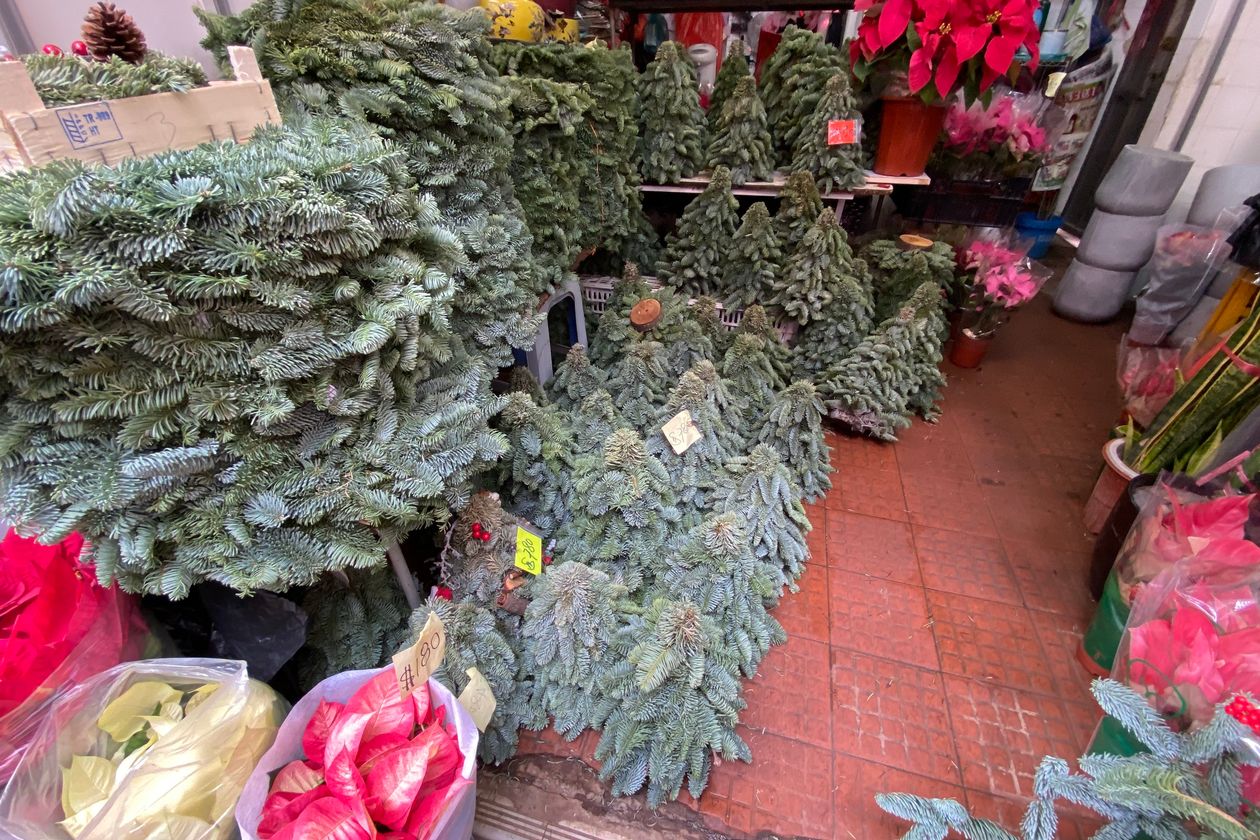On the streets of Hong Kong, 8-foot Noble Firs are selling for as much as $2,167 apiece, while in California and New York shoppers are paying more for what they say are inferior trees. And in the U.K. retailers are scrambling for more trees.
The pandemic means millions are unable to travel over the holiday season, and are celebrating at home instead. That’s produced a spike in demand for trees—and a run on decorations.
Carla St. Germain, a 55-year-old business owner in Fargo, N.D., doesn’t normally buy her tree until mid-December each year, but this year unseasonably warm weather made her go a week earlier than normal. It was a good thing she did.
“When I pulled in on the side street on the side where I normally get my tree it was completely empty,” she said. There were still some 8-foot and taller trees left and “some super tiny short ones that you’d put in the corner of the apartment.” Mrs. St. Germain said she ended up persuading the seller to cut down a larger tree for her. (An 8-foot tree would have been too tall for her house.)
 Knee-high bundles of branches made to look like little Christmas trees are selling for $100 in Hong Kong./PHOTO: SERENA NG/THE WALL STREET JOURNAL
Knee-high bundles of branches made to look like little Christmas trees are selling for $100 in Hong Kong./PHOTO: SERENA NG/THE WALL STREET JOURNAL
“My husband said it’s the most unusual Christmas tree I’ve ever bought,” Mrs. St. Germain said. There is no central trunk to place a tree topper and the branches are all reaching for the ceiling like they’re performing the Village People’s hit song YMCA, she said.
The Christmas tree shortage has its roots in the global recession of more than a decade ago. During those years, a glut of Christmas trees caused prices to tumble, and some farmers planted fewer or switched to other kinds of crops. Other farms just closed. Wild fires on the West Coast also wiped out a number of Christmas tree farms.
Casey Grogan, owner of Silver Bells Tree Farm, a 700-acre Christmas tree farm in Silverton, Ore., said his trees typically take between eight and 12 years to grow. He estimates the smaller supply has pushed up prices by about 30% over the last four years.
“We have retailers asking us to go out and cut more trees, which we are not doing because we have to save some for next year,” he said.
The National Christmas Tree Association says that there is not so much a shortage—if people want a tree they can find one—but that supply has tightened.
Shoppers are also hankering for real trees this year, and started buying early. After a year of being stuck at home due to the pandemic, industry players say people are excited that buying a real tree can come with an outing to a farm.
 Carla St. Germain persuaded her Christmas tree seller to cut down a larger tree because the mid-sized trees had all sold out./PHOTO: KRIS EHLERT
Carla St. Germain persuaded her Christmas tree seller to cut down a larger tree because the mid-sized trees had all sold out./PHOTO: KRIS EHLERT
Mikaela O’Brien and her family spent half a day scouring their favorite Christmas Tree farm looking for an 11- or 12-foot Fir this year near their home in Maple Valley, Wash. They ended up buying something a few feet shorter.
“The taller trees—there just aren’t any,” said the 36-year-old mother of a 12-year-old girl and 9-year-old boy.
“We ended up finding one in the very back corner. It’s still a beautiful tree, it’s just skinnier and smaller and shorter than normal,” she said.“It’s our Charlie Brown tree. It’s a big room and it’s a small tree.”
The family propped the tree up on a four-wheeled dolly to make it stand six inches taller but Ms. O’Brien said that the star topper that was bought for a bigger tree was a bit of a give away. “The star is so big that it’s nearly half the size of the tree,” she said. “It looks silly.”
In Europe retailers, cautious about what lockdowns would mean to sales, reduced their Christmas tree orders and now harvesters are rushing to cut more trees to meet demand across the region, said Claus Jerum Christensen, managing director of the Danish Christmas Tree Association. The U.K. is having to rely on trees from Europe after many of its own farms ran low on trees when sales jumped early.
This year, fewer Christmas trees have been shipped abroad from growers in the U.S. because the pandemic has given a boost to domestic sales.
 A tree sells in Manhattan./PHOTO: CARLO ALLEGRI/REUTERS
A tree sells in Manhattan./PHOTO: CARLO ALLEGRI/REUTERS
Swedish furniture giant IKEA, a popular destination for buying Christmas trees in Hong Kong and Singapore, has run out of them in those cities after meeting with overwhelming demand.
That has shoppers lining up for hours to buy trees from nurseries with incoming shipments, or turning to online sellers ordering lookalikes from China. In the local flower market in Wanchai, Hong Kong, six-foot trees are going for about $1,500, about seven or eight times what they sold for a year ago. Knee-high bundles of branches shaped like trees are going for $100 apiece.
Mihir Melwani, a 22-year-old college student in Hong Kong, said his friends’ struggles to find trees spurred him to do something about the situation. Using the contacts of his father, who works in the logistics business, Mr. Melwani said he arranged for more than 25 trees to be trucked into the city from Northern China.
After mentioning his upcoming sale of trees for $175 each on Facebook, he was contacted by dozens of interested buyers.
“The demand has been crazy—I’ve been getting a message every five minutes,” Mr. Melwani said.
Marie Bernal and her family have been in Hong Kong five years. After a year without travel and a move to a new residence, she decided it was time to trade in her plastic tree for one like she had in the Christmases of her childhood in Mexico City.
 Mihir Melwani a college student in Hong Kong, used connections to import 25 Christmas trees from China./PHOTO: SAMARA MELWANI
Mihir Melwani a college student in Hong Kong, used connections to import 25 Christmas trees from China./PHOTO: SAMARA MELWANI
“I promised the children we are going to get a beautiful tree this year and we’ll go and we’ll pick it out together,” she said. “It’s going to smell wonderful and amazing.”
It didn’t turn out quite like that. Ms. Bernal visited some garden centers two weeks before Thanksgiving only to find that most of the trees were already sold. In a panic, she purchased the last tree at one venue, a roughly six-foot tree imported from the U.S., with a $320 price tag.
“Do I think I’ll do it again? Probably not,” she said. Her 11-year-old daughter didn’t notice the tree in their living room until days after it arrived, and her five-year-old son was nonchalant about it, she said. “The joy was in my head.”
Sean Man, whose family owns Wah King Garden Arts, in Sai Kung, Hong Kong, imports around 700 Noble Firs each year from Oregon that normally sell out around mid-December. This year, they were all sold before the end of November.
Mr. Man said that recently around 40 customers arrived as early as 6 a.m. at the garden center in the hopes of getting hold of the last trees when it opened at 8:30 a.m.
“I was expecting a brawl,” he said, but the buyers were well-behaved and lined up in single file. Not wanting to leave anyone empty handed, Mr. Man is offering to fly in Nordmann Firs from Holland.

 Knee-high bundles of branches made to look like little Christmas trees are selling for $100 in Hong Kong./PHOTO: SERENA NG/THE WALL STREET JOURNAL
Knee-high bundles of branches made to look like little Christmas trees are selling for $100 in Hong Kong./PHOTO: SERENA NG/THE WALL STREET JOURNAL Carla St. Germain persuaded her Christmas tree seller to cut down a larger tree because the mid-sized trees had all sold out./PHOTO: KRIS EHLERT
Carla St. Germain persuaded her Christmas tree seller to cut down a larger tree because the mid-sized trees had all sold out./PHOTO: KRIS EHLERT A tree sells in Manhattan./
A tree sells in Manhattan./ Mihir Melwani a college student in Hong Kong, used connections to import 25 Christmas trees from China./
Mihir Melwani a college student in Hong Kong, used connections to import 25 Christmas trees from China./